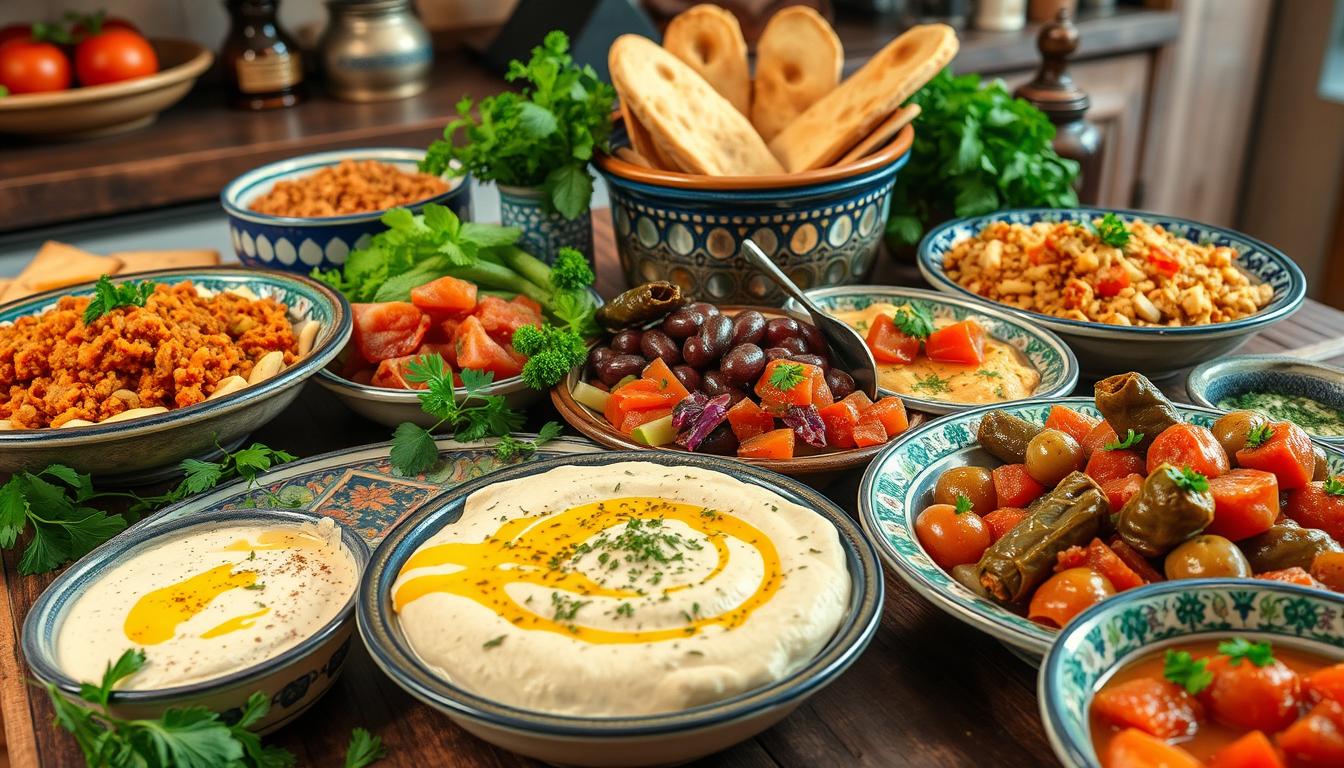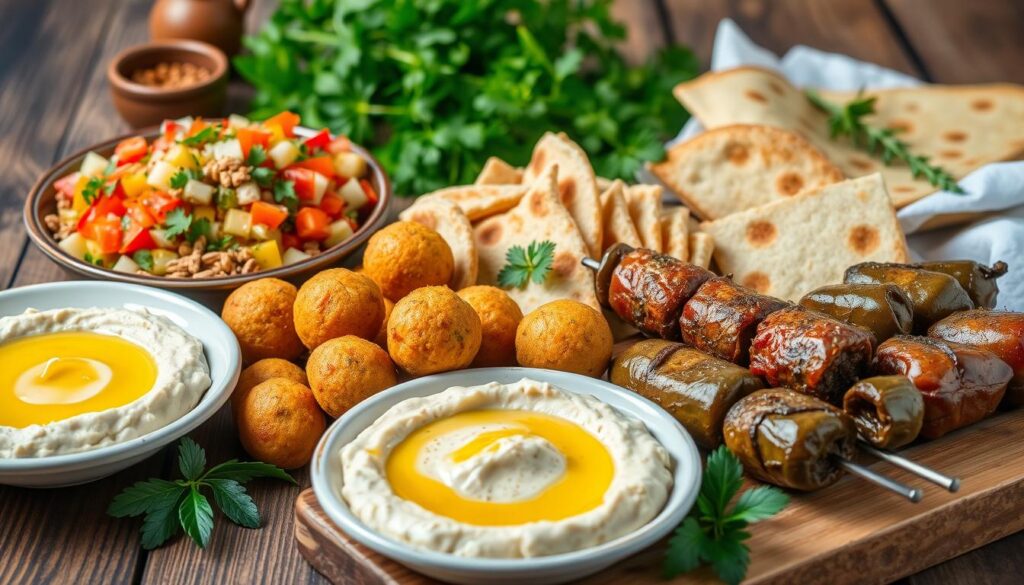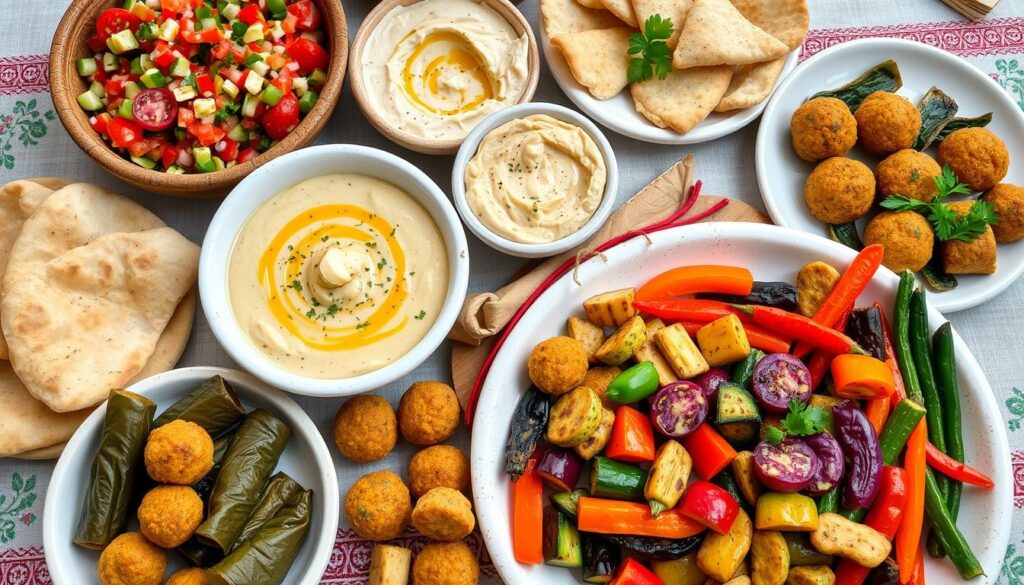The smell of spices and fresh bread reminds me of my grandmother’s kitchen. There, Lebanese food was more than just food—it was a family and tradition celebration. Start your cooking journey with us, exploring simple yet flavorful Lebanese recipes that are easy to make.
Lebanese food brings a world of flavors right to your kitchen. Whether you’re new to cooking or have experience, these 10 recipes will open your eyes to Lebanese cuisine. You’ll find dishes for breakfast, lunch, and dinner that are easy to make and delicious.
We picked these recipes for their simplicity and taste. They need just a few ingredients and simple cooking methods. They’re perfect for those who are short on time but want to try something new.
Key Takeaways
- Discover 10 beginner-friendly Lebanese recipes
- Learn quick and easy cooking techniques
- Explore diverse flavors of Middle Eastern cuisine
- Most recipes take less than an hour to prepare
- Enjoy vegetarian and meat-based options
- Use simple, readily available ingredients
- Expand your cooking repertoire with authentic dishes
Introduction to Lebanese Cuisine and Its Unique Flavors
Lebanese cuisine is a colorful mix of Mediterranean flavors that excites food fans everywhere. It’s more than just cooking; it’s a story of culture, history, and a love for fresh ingredients.
Key Characteristics of Lebanese Food
Lebanese food is special because of its cooking style. It focuses on:
- Fresh, seasonal ingredients
- Herbs and spices galore
- Sharing meals with others
- Good taste and health
Essential Ingredients in Lebanese Cooking
At the heart of Lebanese cooking are a few key ingredients. These include:
- Extra virgin olive oil
- Garlic and lemon
- Fresh herbs like parsley and mint
- Whole grains and legumes
- Yogurt and labneh
“Lebanese food is not just about eating; it’s about celebrating life through flavor.” – Lebanese Chef Ramzi Choueiry
Health Benefits of Mediterranean Diet
The Lebanese diet is great for your health. It often uses chicken instead of red meat. Meals are low in bad fats and high in good stuff. Studies show it can help with cholesterol, blood sugar, and heart health.
Trying Lebanese cooking is more than making a meal. It’s diving into a long tradition of flavor, health, and togetherness.
Essential Kitchen Tools and Ingredients for Lebanese Cooking
Stocking your kitchen with authentic Lebanese pantry staples changes your cooking. Knowing the right ingredients and traditional cooking tools is crucial. It helps you make delicious Middle Eastern dishes full of flavor.
Essential Lebanese Pantry Staples
- Dry Goods:
- Bulgur wheat
- Lentils
- Chickpeas
- Basmati rice
- Oils and Condiments:
- Extra virgin olive oil
- Tahini
- Pomegranate molasses
The Lebanese pantry focuses on 90% plant-based foods, like the Mediterranean diet suggests. Lentils are a nutritional gem, packed with protein, iron, and are low in calories.
Middle Eastern Spices Collection
| Spice | Flavor Profile | Common Use |
|---|---|---|
| Za’atar | Herbal, tangy | Bread seasoning |
| Sumac | Lemony, tart | Meat and salad garnish |
| 7-Spice Blend | Complex, warm | Meat marinades |
Traditional Cooking Equipment
“The right tools make Lebanese cooking an art, not just a task.” – Lebanese Culinary Wisdom
Invest in key traditional cooking equipment like:
- Food processor for smooth hummus
- Grill pan for perfect kafta
- Mortar and pestle for grinding spices
- Large mixing bowls
By gathering these Lebanese pantry staples and traditional cooking tools, you’ll bring authentic Middle Eastern cooking into your home kitchen.
Traditional Lebanese Recipes for Beginners
Starting your Lebanese cooking journey is both exciting and delicious. Authentic and Easy Lebanese recipes are a great way to begin. They turn your kitchen into a lively Mediterranean spot.
Lebanese cooking is easy and fun for everyone. You don’t need to be a pro to make real Lebanese dishes.
Understanding Basic Cooking Techniques
Learn these basic Lebanese cooking skills to make tasty meals:
- Sautéing veggies with olive oil
- Grilling meats with spices
- Slow-cooking stews and grains
- Blending dips and spreads
Common Spice Combinations
Discover real flavors with these spice mixes:
- Za’atar: A blend of herbs, sesame seeds, and sumac
- Lebanese seven-spice mix
- Spices like turmeric, mint, and garlic
Time-Saving Tips for Preparation
Make your Lebanese cooking faster with these tips:
- Make spice mixes ahead of time
- Use canned chickpeas for quick hummus
- Chop veggies in big batches
- Have pre-made pita bread ready
“Cooking Lebanese food is about passion, not perfection.” – Traditional Lebanese Chef
Begin with simple dishes like tabbouleh, fattoush, and hummus. They help you get better at Lebanese cooking.
Quick and Easy Lebanese Breakfast Dishes
Start your day with the lively tastes of Middle Eastern breakfasts. Lebanese recipes mix health with ease, bringing Mediterranean flavors to your home.
Here are some top quick breakfast ideas from the Mediterranean:
- Foul Mdamas: A dish full of protein, made with fava beans, garlic, lemon, and olive oil
- Manakish: A fast-to-make flatbread topped with za’atar or cheese
- Musabaha: A chickpea breakfast that’s both filling and healthy
“Breakfast is the most important meal of the day, and Lebanese cuisine makes it extraordinary!” – Lebanese Culinary Expert
Now, let’s dive into a classic Lebanese breakfast dish:
| Dish | Prep Time | Nutritional Value | Serving Suggestion |
|---|---|---|---|
| Musabaha | 15 minutes | 162 kcal, 6g carbs, 3g protein | Serve with warm pita, fresh vegetables |
Lebanese breakfasts are simple yet versatile. With chickpeas, tahini, lemon, and olive oil, you can make a tasty morning meal. It will give you energy for the day.
Pro tip: For the best taste, use dried chickpeas and fresh ingredients. If you’re in a hurry, canned chickpeas are a great option too!
Popular Lebanese Mezze Recipes
Lebanese appetizers are a joyous tradition that makes meals lively. Middle Eastern small plates, or mezze, are full of flavors that encourage sharing. They are the perfect start to exploring Lebanese cuisine.
Mezze platter ideas show the wide range of Lebanese food. These small dishes are more than just appetizers. They are a way to celebrate food and bring people together.
Cold Mezze Delights
Cold Lebanese appetizers offer refreshing tastes that excite your senses. Some favorites include:
- Tabbouleh – a fresh parsley and bulgur salad
- Fattoush – crispy bread salad with sumac
- Warak enab – stuffed grape leaves
- Labneh – strained yogurt spread
Hot Mezze Selections
Hot Middle Eastern small plates add warm, savory flavors to your platter. Try these tasty options:
- Falafel – crispy chickpea fritters
- Kibbeh – spiced meat and bulgur croquettes
- Grilled halloumi cheese
- Arayes – meat-filled pita pockets
Legendary Dips and Spreads
No mezze platter is complete without a variety of dips. These dips highlight Lebanese culinary skill:
| Dip Name | Key Ingredients | Flavor Profile |
|---|---|---|
| Hummus | Chickpeas, tahini, garlic | Creamy, nutty |
| Baba Ghanoush | Roasted eggplant, tahini | Smoky, rich |
| Muhammara | Roasted red peppers, walnuts | Spicy, tangy |
“Mezze is not just food, it’s a way of life that celebrates community and connection.” – Lebanese Culinary Tradition
Your mezze platter should have a variety of dishes. Serve them with warm pita bread and fresh veggies. The goal is to create a spread that encourages conversation and enjoyment.
Lebanese Main Course Dishes
Explore the world of Lebanese entrees, filled with vibrant flavors and hearty satisfaction. Middle Eastern main dishes are known for their rich culinary traditions. They use nutritious ingredients to make simple meals into extraordinary experiences.
Lebanese traditional meals are a mix of grilled meats, aromatic spices, and wholesome ingredients. These dishes are more than just food. They are a cultural celebration that connects generations through delicious recipes.
Popular Lebanese Main Courses
- Chicken Kafta: Ground chicken mixed with onions and spices, expertly grilled
- Kibbeh: A national favorite made with ground meat and bulgur wheat
- Fasolia: Comforting white bean stew packed with flavor
- Loubia b’Zeit: Hearty green bean stew perfect for family meals
Each dish tells a story of Lebanon’s rich culinary heritage. It brings authentic flavors directly to your kitchen.
“Lebanese cuisine is a celebration of fresh ingredients, bold spices, and generations of cooking wisdom.” – Middle Eastern Food Expert
Cooking Techniques
| Dish | Primary Cooking Method | Typical Preparation Time |
|---|---|---|
| Chicken Kafta | Grilling | 25-30 minutes |
| Kibbeh | Baking/Frying | 45-60 minutes |
| Fasolia | Stewing | 60-90 minutes |
When preparing these Lebanese entrees, use fresh ingredients and traditional cooking methods. This will help capture the authentic taste of Middle Eastern main dishes.
Authentic Lebanese Rice and Grain Dishes
Explore the world of Lebanese rice recipes that add warmth and flavor to your meals. Middle Eastern grain dishes are more than sides. They are culinary art that shows off Lebanese cooking traditions.
Lebanese cooking turns simple ingredients into amazing meals. The secret of traditional bulgur preparations is in their ability to make dishes that bring people together.
Different Types of Rice Preparations
Start your Lebanese rice journey by learning key preparation techniques. Classic Lebanese rice uses:
- Basmati rice as the main grain
- Vermicelli noodles for extra texture
- Olive oil for authentic taste
- Careful toasting of vermicelli before adding rice
Bulgur and Lentil Combinations
Mujadara is the top grain dish in Lebanese cuisine. It mixes lentils and rice in a simple yet powerful way. This vegetarian dish shows how Lebanese cooking turns simple ingredients into amazing meals.
Traditional Serving Methods
Serving Lebanese rice needs attention to detail. Chefs often shape rice into elegant mounds or use it as a base for grilled meats and stews. The way it’s presented is as important as how it’s made.
“In Lebanese cooking, rice is not just food – it’s a celebration of culture and community.”
Whether you’re making a quick weeknight meal or hosting a big event, these Lebanese rice recipes will take your taste buds to the Middle East.
Lebanese Vegetarian Recipes
Lebanese cuisine is full of amazing plant-based dishes that will excite your taste buds. These vegan Mediterranean recipes are not only healthy but also bursting with flavor. They make eating vegetarian a joy.
“Lebanese vegetarian dishes prove that meatless meals can be both nutritious and incredibly delicious!” – Chef Zahra
Discover these delicious Middle Eastern vegetarian dishes that highlight Lebanon’s rich culinary tradition:
- Mujadara: Lentils and rice with caramelized onions
- Falafel: Crispy chickpea fritters
- Stuffed grape leaves with rice and herbs
- Fattoush: Fresh herb and bread salad
- Baba ganoush: Smoky eggplant dip
Trying these classic dishes is essential for your vegan Mediterranean recipes journey. Each dish is a perfect mix of nutrition and taste. They use traditional spices like za’atar, cumin, and paprika.
| Dish | Preparation Time | Calories per Serving |
|---|---|---|
| Mujadara | 30 minutes | 282 kcal |
| Falafel | 25 minutes | 250 kcal |
| Baba Ganoush | 20 minutes | 200 kcal |
Pro tip: Most of these plant-based Lebanese food recipes can be made ahead of time. This makes meal planning easy for those with busy schedules.
Simple Lebanese Desserts
Lebanese sweets take you on a journey through Middle Eastern desserts. They mix rich flavors, aromatic ingredients, and old traditions. These treats show the heart of Lebanese cuisine with nuts, honey, and floral scents.
Traditional Sweet Treats to Savor
Explore authentic Lebanese desserts that bring Beirut’s streets to your taste buds. Try these must-haves:
- Namoura: A semolina cake soaked in sweet syrup
- Baklava: Layers of crispy phyllo dough filled with nuts
- Knafeh: A cheese pastry dripping with sugar syrup
- Ma’amoul: Stuffed cookies with pistachio or date fillings
Modern Culinary Adaptations
Today’s Lebanese sweets are getting healthier. Bakers use gluten-free ingredients, new sweeteners, and creative ways to keep the old taste.
| Dessert | Traditional Ingredient | Modern Adaptation |
|---|---|---|
| Namoura | Semolina Flour | Gluten-Free Semolina |
| Baklava | Sugar Syrup | Honey or Agave Sweetener |
Serving Suggestions
Enjoy Lebanese desserts with strong Arabic coffee or herbal tea. They’re best fresh and shared with loved ones.
“In Lebanon, desserts are not just food; they are a celebration of culture and connection.” – Lebanese Culinary Expert
Whether you love desserts or want to try Middle Eastern cuisine, Lebanese sweets are a flavorful adventure. They’ll make you want more.
Tips for Storing and Reheating Lebanese Food
Keeping Middle Eastern dishes fresh is all about smart storage. It helps keep the flavors and quality just right. Knowing how to store food can make your favorite Lebanese meals last longer.
- Refrigerate dips like hummus and baba ghanoush in airtight containers
- Keep stews and grain dishes for 3-4 days maximum
- Use sealed containers to prevent moisture loss
Reheating Lebanese dishes the right way is key to keeping their unique textures:
| Dish Type | Storage Duration | Reheating Method |
|---|---|---|
| Rice Dishes | 4-5 days | Gentle microwave with splash of water |
| Grilled Meats | 3-4 days | Skillet or oven at low temperature |
| Stuffed Grape Leaves | 3 days refrigerated | Steam or warm in covered pan |
“Proper storage transforms leftovers into delicious next-day meals” – Lebanese Culinary Experts
Some Lebanese dishes, like mujadara, can be frozen for up to 3 months. This makes meal prep easier and helps reduce food waste. Always cool dishes completely before refrigerating or freezing to keep the taste and texture best.
- Use shallow containers for faster cooling
- Label containers with date of preparation
- Avoid storing at room temperature for more than 2 hours
Conclusion
Exploring Lebanese cuisine opens a world of vibrant flavors and rich traditions in your kitchen. You’ve learned how simple ingredients like olive oil, fresh herbs, and spices can make meals special. Each recipe connects you to Lebanon’s diverse cultural heritage.
The Lebanese culinary journey is more than cooking. It’s about understanding the traditions behind these dishes. From mezze platters to desserts, each recipe shares stories of family, community, and the Mediterranean lifestyle. You’ve gained more than cooking skills; you’ve embraced a holistic approach to nutrition and flavor.
Your knowledge of Lebanese cooking shows that healthy, delicious meals are accessible and exciting. The focus on fresh veggies, lean proteins, and wholesome grains reflects a balanced diet. As you keep trying new recipes, you’ll find joy in creating meals that celebrate cultural richness.
Remember, cooking is an adventure of continuous learning. Each dish you make brings you closer to the incredible depth and warmth of Lebanese culinary traditions. Enjoy your newfound skills and keep exploring the delightful world of Lebanese cuisine.
FAQ
What are some essential ingredients in Lebanese cooking?
Is Lebanese cuisine vegetarian-friendly?
What are some easy Lebanese breakfast dishes for beginners?
How can I store and reheat Lebanese dishes?
What is mezze in Lebanese cuisine?
Are Lebanese desserts very sweet?
What cooking tools are helpful for Lebanese cuisine?
Is Lebanese cuisine part of the Mediterranean diet?
Source Links
- Easy Lebanese Recipes by Zaatar and Zaytoun – Lebanese food blog – https://zaatarandzaytoun.com/easy_lebanese_recipes/
- The 35 BEST Lebanese Recipes – https://gypsyplate.com/the-best-lebanese-recipes/
- Lebanese cuisine – https://en.wikipedia.org/wiki/Lebanese_cuisine
- Lebanese Food: The Best Kept Secret – https://olivealittle.com/blogs/blog/lebanese-food-the-best-kept-secret?srsltid=AfmBOop9mmcF7mFSGxzmDzejmrRboBMTrARQg4maXQ9Je_lhrym7im1E
- What’s in my Pantry? – https://www.simplyleb.com/whats-in-my-pantry/
- Lebanese Food: The Best Kept Secret – https://olivealittle.com/blogs/blog/lebanese-food-the-best-kept-secret?srsltid=AfmBOoq2CoALtyzR86aZ31-cJlEiNLyJsBVkaR0MARf9VAquIhM6rjZa
- Traditional Toum (Lebanese Garlic Sauce) – https://www.seriouseats.com/traditional-toum
- The Best Traditional Lebanese Food Dishes (24 Recipes) – The Matbakh – https://thematbakh.com/best-traditional-lebanese-food-dishes/
- Lebanese chicken and rice – Caroline’s Cooking – https://www.carolinescooking.com/lebanese-chicken-and-rice/
- Easy Creamy Lebanese Musabaha (Chickpeas Breakfast) – https://plantbasedfolk.com/musabaha/
- Lebanese breakfast eggs and tomatoes by Zaatar and Zaytoun – https://zaatarandzaytoun.com/eggs-and-tomatoes/
- Ultimate Mediterranean Mezze Platter (Lebanese Mezze) – Maureen Abood – https://maureenabood.com/lebanese-mezze-platter/
- 12 Lebanese Mezze Dishes You Need To Try At Least Once, Recommended By A Middle Eastern Recipe Developer – Tasting Table – https://www.tastingtable.com/1590383/lebanese-mezze-dishes-try-once/
- Mezze Platter – Love and Lemons – https://www.loveandlemons.com/mezze-platter/
- Lebanese Dishes You Must Try, from Hummus to Kanafa – https://www.finedininglovers.com/explore/articles/lebanese-dishes-you-must-try-hummus-kanafa
- Lebanese Rice – https://feelgoodfoodie.net/recipe/lebanese-rice/
- Lebanese Rice – https://amiraspantry.com/lebanese-rice/
- Lebanese Chickpea Stew – https://holycowvegan.net/lebanese-chickpea-stew/
- Vegan Lebanese Recipes byZaatar and Zaytoun – Lebanese Food Blog – https://zaatarandzaytoun.com/vegan-lebanese-recipes/
- Namoura Recipe | Lebanese Dessert | Cook’s Hideout – https://www.cookshideout.com/namoura
- 15 Authentic Lebanese Desserts – https://feelgoodfoodie.net/lebanese-desserts/
- A Delicious Guide to Lebanese Desserts – Chef Tariq – https://www.cheftariq.com/guides/lebanese-desserts/
- Lebanese Mujadara – https://feelgoodfoodie.net/recipe/mujadara/
- Lebanese Stuffed Pita (Arayes) – https://silkroadrecipes.com/arayes-lebanese-meat-stuffed-pitas/
- Best Lebanese Stuffed Grape Leaves Recipe (Warak Enab) – https://maureenabood.com/lebanese-stuffed-grape-leaves/
- A Taste of Lebanon With Lebanese Cuisine – https://wrapitupreno.com/lebanese-cuisine/
- lebanese – Cedarseed – https://cedarseed.com/tag/lebanese/
- The Best Authentic Lebanese Recipes – Mediterranean Living – https://www.mediterraneanliving.com/the-best-authentic-lebanese-recipes/




1 thought on “Top 10 Easy Lebanese Recipes to Try at Home”